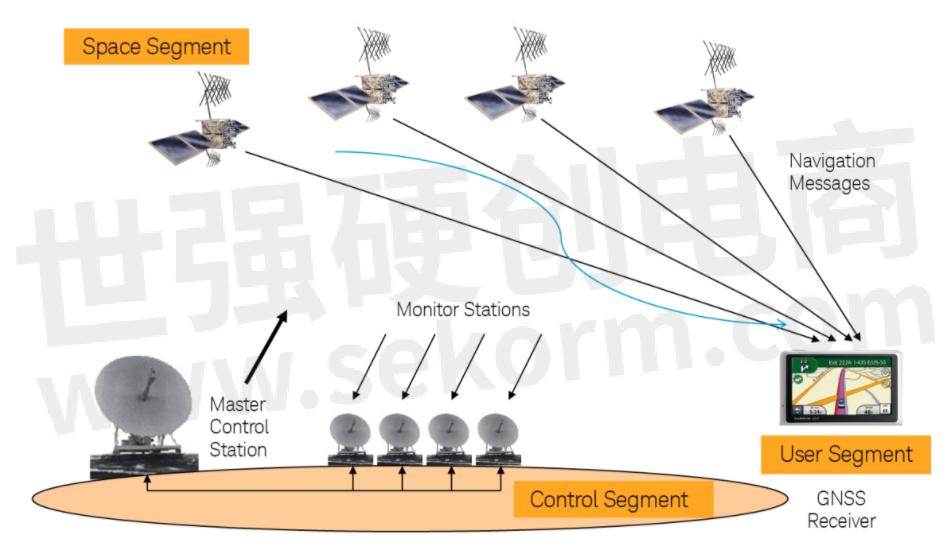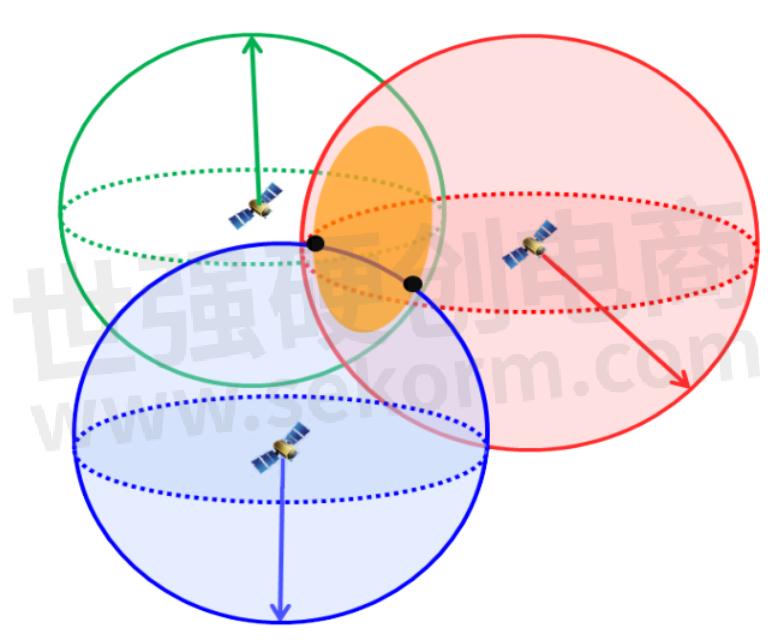Testing Global Navigation Satellite Systems (GNSS) Receivers

Global Navigation Satellite Systems (GNSS) is a generic term used for systems that determine the location of a user based on information from satellites. There are 4 major types of systems presently used in different regions of the world: GPS, GLONASS, Beidou, and Galileo. Outside of these major GNSS systems, there are also satellite-based augmentation systems (SBAS) which are geostationary satellites that provide data to improve the positioning accuracy of GNSS receivers in a region. A few of these include the Wide Area Augmentation System (WAAS) for North America, European Geostationary Navigation Overlay Service (EGNOS) for Europe, the Japanese Multi-functional Satellite Augmentation System (MSAS), and the Indian GPS Aided Geo Augmented Navigation (GAGAN) system.
How GNSS functions
GNSS can be simplified into 3 segments. The space segment consists of satellites or space vehicles, which transmit a navigation message with information about the satellite's orbit and position and the time of the transmission. The control segment consists of monitoring and control stations on the ground that track the satellites in view, collect data from the transmissions, and provide navigation information updates (atmospheric and correction information, and satellite control). Lastly is the user segment which is the GNSS receiver. Cell phones and automotive infotainment centers are examples of GNSS receivers.

Figure 1. The three major segments of a GNSS system
A GNSS receiver determines its location through a process called trilateration. It uses the transmitted time and position data in a navigation message to measure the time delay for the signal from the satellite and calculate its distance from that satellite, called the pseudo-range. The distance from each satellite gives a sphere on which the receiver could be located. The intersection of 2 spheres is a circle, and the 3 spheres intersect at 2 points as shown in Figure 2. At times a fourth data point can be needed. Simultaneous measurements from at least 4 satellites allow the receiver to correct for clock errors and determine the correct time, in addition to determining its latitude, longitude, and altitude.

Figure 2. A GNSS receiver calculating the distance to at least 3 satellites
Testing options and methods
Unlike most wireless digital systems, the different variations of bit error rate testing, such as BER, FER, PER, or BLER, are not ideal for a GNSS receiver. Most navigation message data is transmitted at only 50 bits per second so checking for a typical BER of 1 in 106 would require an exorbitant amount of time. Instead, the focus is on verifying a receiver's ability to acquire and track a satellite signal and then checking the receiver's ability to calculate a location fix at various power levels in combination with varying conditions. Time to first fix (TTFF) receiver sensitivity and location accuracy are the most common GNSS receiver verification methods. TTFF is the time between the "turn-on" of the GNSS receiver and the acquisition of a location fix. TTFF can be tested under cold, warm, and hot start conditions. In a cold start, the GNSS receiver has no almanac data that gives location data about the satellites. It must search each possible PRN code and search over a frequency range of around ±5kHz to account for Doppler shift in the satellite signals. With a warm start, the receiver retains the approximate time, last location, and almanac data to use for acquiring the satellites faster. With a hot start, the receiver also remembers the last satellites that were used and tries to acquire them again. A hot start is only used when a receiver has been off for a short time and has not moved much.
Hardware and software solutions
It is possible to test a GNSS receiver by using an antenna and trying to receive off-the-air signals. While this approach is realistic, it can only provide limited information because the signals presented to the receiver are highly variable and non-repeatable. There may not be adequate satellite signals available at a particular location and time. In addition, testing under specific conditions, such as in particular locations or at high velocities, can become expensive and impractical.
A record-and-playback system can also provide simulated GNSS signals to test the receiver. While this system does provide a very repeatable test signal, it is not possible to modify the recorded signals, make adjustments to individual satellite signals, or add impairments in real-time while the signals are playing back.
To address these issues, a GNSS signal simulator may be used. A GNSS signal simulator produces an output signal that models the signal that would be received by the GNSS receiver: a mix of signals from many different satellites at different time delays, Doppler shifts, and power levels. A real-time GNSS simulator allows modifications to the signal while it is being generated. Another advantage is that a GNSS simulator can simulate satellites that are not yet present in the real world, allowing earlier testing of systems like Galileo and Beidou before the satellites are fully deployed.

Figure 3. Keysight N7609B Signal Studio GNSS solution configuration
- +1 Like
- Add to Favorites
Recommend
- Keysight Technologies Acquires Quantum Benchmar, Augmenting Keysight‘s Quantum Portfolio
- Keysight First to Gain GCF Approval of Cases for Validating 5G New Radio mmWave Devices in Standalone Mode
- Keysight‘s O-RAN Test Solutions Enable Xilinx to Accelerate Development of Massive MIMO Radio Reference Design
- Keysight and Transphorm Create Power Supply Reference Design that Lowers Product Costs; Speeds Time to Market
- Keysight Massively Parallel Board Test System Selected by LACROIX in Automotive Printed Circuit Board Manufacturing
- Keysight, TIM and JMA Wireless Join Forces to Showcase O-RAN Technology at Mobile World Congress 2021
- Keysight First to Gain OmniAir Qualified Test Equipment Status, Accelerating C-V2X Device Certification
- Keysight Delivers New Solution for Benchmarking 5G End-user Quality of Experience in Indoor Environments
This document is provided by Sekorm Platform for VIP exclusive service. The copyright is owned by Sekorm. Without authorization, any medias, websites or individual are not allowed to reprint. When authorizing the reprint, the link of www.sekorm.com must be indicated.





























































































































































































































































































































































































































































































































































































































































































































































































































































































